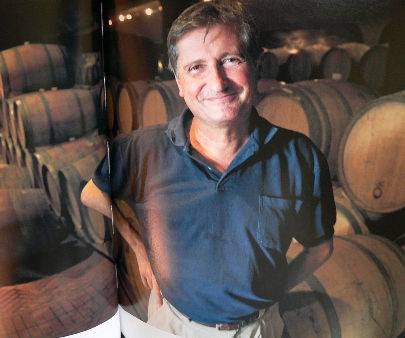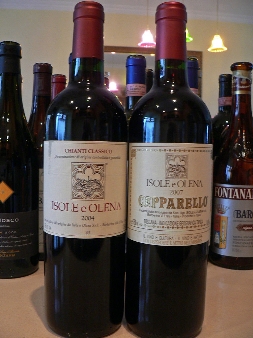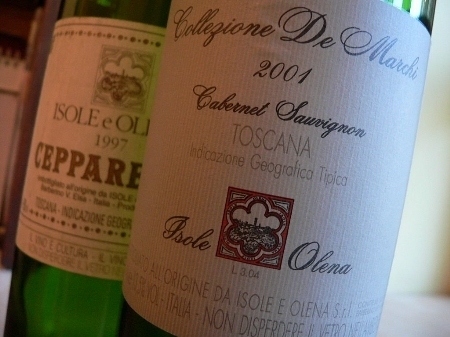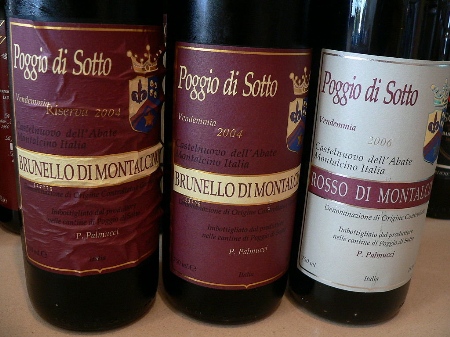Views: 74
我的上一篇網誌想說明的是﹕意大利很古老的 Tuscan 地區孕育了很古老的葡萄 Sangiovese ,而在過去很長的一段時間裏,這是當地最 mass market 的飲料,所以沒有人會太講究品質。
戰後的經濟繁榮出現了,機會來了,Tuscan 酒莊面對的挑戰是﹕Sangiovese 可以釀造 fine wine 嗎?

其中一位先行者是 Isole e Olena 的莊主 Paolo de Marchi ,從 Kyle Phillips 的一篇訪問報導,我們可以看到他走過一條怎麼樣的路﹕
Then Paolo was still intrigued by the prospect of using extra-Tuscan grapes to add polish and luster to Chianti Classico … Paolo planted a vineyard of Cabernet, "in part because the land was good for Cabernet grapes, and in part because everyone else was doing it." He had originally thought to use the Cabernet to improve the body and color of his Chianti Classico, but then decided that the Cabernet would overpower the Sangiovese. He finally decided that the ideal grape to compliment Sangiovese is Syrah, the noble French grape from the RhoneValley, and planted a few acres of it. However, by the time the vineyard came into production, he was having second thoughts about the whole idea of using complementary grapes: "They need to be reconsidered," he says. "Tuscany's strength, like that of any wine producing region, lies in the typicity of the wines, the unique characteristics that make the wines undeniably Tuscan." These characteristics come primarily from the Sangiovese grape, and he has now come to the conclusion that Tuscans must work with their Sangiovese clones (a clone is a variety of grape), selecting only those that produce the best grapes so as to produce the best possible wines.
Paolo's belief in the importance of the typicity of the wines is not merely snobbery; he exports to 26 (at last count) countries, has worked in California, has visited Australia repeatedly, and has tasted wines from all over the world. Australia has tremendous resources, Chile has very low labor costs, as does South Africa, and Eastern Europe is an unknown quantity that may turn out to be a sleeping giant. As he points out, almost anyone can turn out an "international" wine with a significant component of Cabernet and other grapes, and do an excellent job; the Tuscan producers who follow this path in an attempt to appeal to international taste could find themselves priced out of the market because their costs are much higher than those of competitors who are able to employ cheap labor or mechanization. If, instead, they work to produce the best Tuscan wines possible, they will be producing something that is uniquely theirs, and which will be always sought after by connoisseurs.
You may be wondering, at this point, what Paolo does with the grapes from his Cabernet and Syrah vineyards. Make wines, which he labels Collezione De Marchi. There is Cabernet Collezione De Marchi, which has won Gambero Rosso's coveted 3 goblets and Parker scores in the high 90s, L'Eremo, a Syrah that placed fourth in a blind tasting a few years ago, behind three great Rhone Valley wines, and Chardonnay Collezione De Marchi, a barrel-fermented Chardonnay that Paolo is still not completely satisfied with, "though it gets better every year."
The Isole e Olena label, on the other hand, is reserved for the traditional Tuscan wines one would expect of an estate in the Chianti Classico region. There's Chianti Classico, made from about 80% Sangiovese, Canaiolo, and (if the year requires it) up to 5% Syrah. Then there's Cepparello, "what Isole e Olena is all about," an extremely refined 100% Sangiovese table wine that would have been Paolo's Chianti Classico Riserva had the DOC commission allowed Chianti Classico to be made from just Sangiovese… Finally, there is Vinsanto, Tuscany's traditional wine of welcoming and conviviality, which is made from white grapes (Malvasia and Trebbiano) that are picked early in the harvest, allowed to wither into raisins, pressed in January, and then barrel-fermented and aged for 4 years before bottling. Paolo's yields are ridiculously small, and his Vinsanto is considered one of the top Italian dessert wines.
Kyle Phillips 的原文見﹕Isole e Olena's Paolo De Marchi (about.com)
Paolo de Marchi 是個典型的 Renaissance Man ,我以前但以為他是位藝術家,現在才知道他還有很實際的考慮﹕國際葡萄即使能種得好,他們的競爭力不會比得上新世界地區。仿照余英時先生所創的「士魂商才」一詞,我想 Paolo 有的是「藝魂商才」。他從父親手裏接管酒莊以前,從沒有種葡萄與釀酒的經驗,也沒有管理過農場,全憑沉實的性格,以及謙虛和努力不懈的精神,他竟然不用顧問的幫助之下在 1980 年創造出純 Sangiovese 的傑作 Cepparello 。
我在前文 漫步 Chianti (之一): The Renaissance of Sangiovese 裏曾對 Cepparello 有過這樣的描述﹕
Cepparello 兼具 Sangiovese 的身體和 Barolo 的精神,因為他的果味深沉難測(Paolo 性格的流露?),有一種內斂的張力,我隱約覺得他帶著介乎 Barolo 與 La Morra 之間的韻味(兩條 Barolo 村的名字)。
很多人有錯覺,以為 Brunello 比 Chianti 高一級,我覺得這是個最大的誤解。Cepparello 和很多「Chianti 經典」絕對可以與意大利甚至全世界最好的酒平起平坐。如果說他有什麼及不上之處,那便是他的價格太低了。我常想起我的意大利好友 Carlo 的名言﹕世界上最好的酒差別只在價錢。
但在這裏更重要的是看到 Isole e Olena 有一整系列的酒,每一顆都是珍珠。

典型 Chianti 酒莊的 Sangiovese 組合﹕基本版與升級版
酒莊的年產量約二十萬瓶,大部分是 Sangiovese ,其中掛著 Chianti Classico 的佔了十五萬瓶,Cepparello 才三萬瓶(所有 Sangiovese 的六份之一)。這是很典型的 Chianti 格局,兩瓶酒的品質區別有點像 Bordeaux 的正牌酒與二房酒之別,但意大利的做法嚴謹得多。最高級別的Cepparello 只在好年份選最好的葡萄釀造。如果年份不好,所有葡萄會放在基本級別的 Chianti Classico ,這好比 Chateau Lafite 在較弱的年份只出小拉菲而不出正印 Chateau Lafite 一樣,放在 Bordeaux 這絕對是不可思議的事情。在這方面,意大利對消費者公道得多!

更別具特色的是三種用國際葡萄釀造的酒﹕ Cabernet Sauvignon、Syrah 和 Chardonnay ,合起來每年一共只有 25,000 瓶左右,對于前兩者,Nicolas Belfrage 的看法是﹕Each of them, in any given year, is a contender for the best wine of its type in Italy 。我只喝過兩個年份的 Cabernet Sauvignon ,我認為他們不像 Bordeaux,但比 Bordeaux 更好喝! Syrah 我一直都找不到,這是我很期待的酒。
我花了那麼多篇幅來介紹 Isole e Olena ,是因為他們比較有代表性,一方面可以看到他們怎麼從無到有的跨進 fine wine 的門檻;他們與時間競賽,與國際對手競賽,所以沒耐性等待 Chianti 公會對產區規定的緩慢調整。既然有市場,為什麼要等到 DOCG 容納 100% Sangiovese 的酒才推出 Chianti Classico Riserva Cepparello?既然有市場,為什麼不同時造國際葡萄的酒? IGT 和 Super Tuscans 是市場逼出來的!
Isole e Olena 的產品結構也是非常適應市場的發展的。他們的入門產品 Chianti Classico 的產量最大,這是過去 mass market 格局的延伸,Cepparello 是產品升格,而 Cab、Syrah 則是新品種。經典市場理論裏的四個 P(Product , Price, Place and Promotion)的頭一個是 Product,我認為 Tuscany 的酒莊在這方面幾乎拿滿分!
但另一個 P “Promotion” 卻幾乎拿了個大光蛋,那是因為 wine writers 長期以來的大罷工。Burton Anderson 二十年前在他的 The Wine Atlas of Italy 一書裏,曾經有如此觀察﹕
I’ve often wondered why it took so long for writers from afar to arrive with their notebooks and spit buckets to analyze the nuances of Barolo or Brunello on the spot. Or why importers took so long to find their way past Italy’s wine factories and start knocking at estate doors. More than complacency, I suspect, it was fear of the unknown. Even today many people have only vague ideas about where Italy’s come from.
證諸可以呼風喚雨的 Robert Parker ,可見 Burton Anderson 說得一點都沒錯。我翻查過 Parker 對 1985 或以前的 Tuscan 酒的評論,發現他只評過 16 次,而且全要等到 1992 年以後。第一次是 1992 年 8 月,他評了 3 瓶 Brunello ,2 瓶 Chianti ,從最低的 88 分到最高的 92 分都有。四個月後,他又評了 4 瓶 Super Tuscans (除了 Tignanello ,都是 Bordeaux blends ),最低 92 分,最高竟然有100 分,這便是最多人認識的 1985 Sassicaia。
所以大眾對意大利酒缺乏認識,首先可怪罪于 Robert Parker 。套用最近城中一個熱門話題﹕成也 Parker ,敗也 Parker。連 Parker 也懶于理會意大利,自然怪不了他的跟隨者了。
Burton Anderson 還算客氣,他說他懷疑酒評人之所以保守,是出于 fear of the unknown 。如果要我猜,我看一則是偏見(Parker 用的是 Bordeaux palate),另一個原因更簡單﹕wine writer 也要吃飯。
Robert Parker 從 2003 年開始找來了 Daniel Thomases 負責評論意大利酒,其後在 2006 年又換上 Antonio Galloni ,所以今天在 erobertparker.com 的世界裏,意大利終于與 Bordeaux 和 Burgundy 平起平坐了。
但在亞洲,我們的知識與二十年前好像差不了許多。所以我最近讀了一位酒富五車的 MW 對意大利酒的一篇莫名其妙的評論後,不禁要問一句﹕
I'm just wondering what an MW is really about: as an adjunct to the wine trade, or a force of vino enlightenment. (見前文﹕Leonardo da Vinci is not a DOCG!)
Promotion 做得不好,Place (distribution) 和 Price 便無從談起了。所以更好的產品,也發行得不好,價錢也上不去。
我相信 wine writers 終于會清醒過來的,但今天趁意大利酒那麼 confusing ,價錢上不去的時候,何不多喝幾瓶?
要從 Tuscan 酒的迷宮走出來,我認為秘訣只有一條﹕拋開 DOC、DOCG、IGT、Super Tuscan 等等的名相,回歸到最根本的元素﹕Producer、Grapes 和 Place。
拿上面介紹過的 Isole e Olena 產品結構做例子,這在 Tuscany 是很典型的,無論是 Chianti 、 Brunello di Montalcino 或 Vino Nobile di Montepulciano ,一般都是以幾款 Sangiovese 的酒為主體,這些酒會高高低低的從 daily drinking wine 到 fine wine 分開兩級或三級,名稱可能掛 Chianti 稱號,也可能是一瓶 IGT,名字不重要,最重要是瓶裏物。此外,比較大的酒莊一般會有一兩款用國際葡萄釀造的酒,而且很多是用單一葡萄的(Cabernet、Merlot 或 Syrah),這些酒必定是 IGT。
讓我先說說一般人覺得比較清晰的 Brunello di Montalcino 。
Brunello 與其他兩個產區的主要差別是他的地理條件;他最靠近海,而且東南部有高山作屏障,所以三區中以他最溫暖和乾燥,Brunello 所出的酒,也就比較 polished 了,總有點公子哥兒的味道。
Brunello 的另一特點是這裏大部分是小酒莊,一般年產量只有幾萬瓶,而且規定是用單一葡萄 Sangiovese Grosso 釀造的,所以也較少有 IGT 酒。酒莊多以基本Brunello 為主,很多莊把較年青的葡萄釀成 Rosso di Montalcino ,但產量也不會比基本 Brunello 大很多。個別酒莊或會另選最好的葡萄釀造數量很少的 Riserva 級別 Brunello ,變成一共三個級別,但主打很多時候還是基本的 Brunello,因此 Brunello di Montalcino 不可與基本的 Chianti Classico 比較,因為 Brunello di Montalcino 是 fine wine 而不是 daily drinking wine。真的要比較應該用 Rosso di Montalcino,但我個人認為 Rosso 也絕非 daily drinking wine ,不放他十年八年是不會開放的。要選 daily drinking wine,非Chianti Classico 莫屬。

典型 Brunello di Montalcino 酒莊的三級產品組合﹕高、中、低
試以名莊 Poggio di Sotto 為例,他們年產 Brunello 約兩萬瓶,Riserva 約兩千瓶,Rosso 則大約一萬瓶。因為酒莊不大,他們好像沒有用國際葡萄釀酒。
Brunello 比較好的酒我在另一篇文章 From Burgundy to Brunello 已介紹過了,在下一篇我會集中介紹另外兩個區的好酒。
Hi, Mr Heart, I read a lot of your post since last year. Until now, it is the first comment to your post. I followed some of your suggestion and tried Cepparello 2005 a few months ago. But unfortunately what I remember is "good but unimpressvie". However, I found most of 2005 vintage have this problem (Sassicaia, IL Poggione Brunello), Instead, Poggio di Sotto Rosso 2007 is great! This baby brunello is floral and sweet, with typical sangiovese acidity. I would say it outpace some Brunello!
[版主回覆08/26/2011 23:32:00]Interesting to hear about the 2005 Cepparello. I have only had a few Sangiovese bottles from 2005. My impression is this is a delicate, or feminine vintage rather than the more robust 2004 and 2006, and should perhaps be enjoyed as such. I always remember what Monica Soldera told us: Nature was different. Seen in this light, the few 2005s I had are mostly lovely, including Soldera's Pegasos.
Nice to hear about the 2007 Rosso from Poggio di Sotto. Sangiovese from good producers is almost always pleasing.
順流易;逆流難,把自身的品味跟味覺交托他人,自己就不用為自己負責 . 可惜,錯失了世上很多好東西!
[版主回覆08/31/2011 11:05:00]有道理,但想想看﹕把自身品味跟味覺完全交托給自己,也可能錯失不少好東西。最好是心無罣礙,但又有誰真能做到?
一直拜讀你的文章,寫的真的很好很專業。希望有機會能一起共飲。